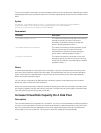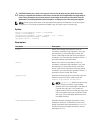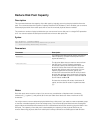
NOTE:
The MD storage management software collects recovery profiles of the monitored storage arrays
and saves the profiles on a storage management station.
The physicalDisk parameter supports both high-capacity expansion enclosures and low-capacity
expansion enclosures. A high-capacity expansion enclosure has drawers that hold the physical
disks. The drawers slide out of the expansion enclosure to provide access to the physical disks. A
low-capacity expansion enclosure does not have drawers. For a high-capacity expansion enclosure,
you must specify the identifier (ID) of the expansion enclosure, the ID of the drawer, and the ID of
the slot in which a physical disk resides. For a low-capacity expansion enclosure, you need only
specify the ID of the expansion enclosure and the ID of the slot in which a physical disk resides. For
a low-capacity expansion enclosure, an alternative method for identifying a location for a physical
disk is to specify the ID of the expansion enclosure, set the ID of the drawer to 0, and specify the ID
of the slot in which a physical disk resides.
If you attempt to recover a virtual disk using the physicalDisk parameter or the physicalDisks
parameter and the physical disks are in an unassigned state, the RAID controller module
automatically creates a new disk group. Use the newVirtualDiskGroup parameter to specify a name
for the new disk group.
You can use any combination of alphanumeric characters,underscore (_), hyphen(-), and pound (#)
for the names. Names can have a maximum of 30 characters.
The owner parameter defines which RAID controller module owns the virtual disk. The preferred
RAID controller module ownership of a virtual disk is the RAID controller module that currently
owns the disk group.
Preallocating Storage Capacity
The dssPreallocate parameter enables you to assign capacity in a virtual disk for storing information that
is used to rebuild a virtual disk. When you set the dssPreallocate parameter to TRUE, the storage space
allocation logic in the RAID controller module firmware preallocates the space in a virtual disk for future
segment size changes. The preallocated space is the maximum allowable segment size. The
dssPreallocate parameter is necessary for properly recovering virtual disk configurations that are not
retievable from the RAID controller module data base. To turn off the preallocation capability, set
dssPreallocate to FALSE.
Segment Size
The size of a segment determines how many data blocks that the RAID controller module writes on a
single physical disk in a virtual disk before writing data on the next physical disk. Each data block stores
512 bytes of data. A data block is the smallest unit of storage. The size of a segment determines how
many data blocks that it contains. For example, an 8-KB segment holds 16 data blocks. A 64-KB segment
holds 128 data blocks.
When you enter a value for the segment size, the value is checked against the supported values that are
provided by the RAID controller module at run time. If the value that you entered is not valid, the RAID
controller module returns a list of valid values. Using a single physical disk for a single request leaves
other physical disks available to simultaneously service other requests.
238


















